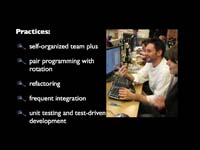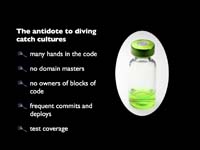I’ve written about how our agile practice, particularly continuous improvement, has re-organized our product and development group into one, high performing team. How this has resulted in less code, less waste, higher quality and more value.
Jeff Sutherland talks about mature, agile teams achieving what he calls hyperproductivity. At this point, the team output accelerates and they outpace the organization around them.

Performing beyond even our own expectations allows us slack to help our product team and our sponsors define the work we do. As a matter of fact, last week, the dev team accounted for 9 of 15 stories in our backlog including 5 consumer facing additions or changes. Our sponsors have so much trust in both our ability to deliver work and our judgement that we have top down support behind the kinds of necessary efforts companies find hard to justify like platform and framework upgrades.
It is a virtuous circle, performance allows slack, slack allows time for reaching outside the immediate task to understand and optimize work for the next week, to keep up with our training and industry, to get out of the room and talk to the business, to imagine new features, to identify and solve problems.
Team members are allowed an opportunity to express their individual talents and interests: one developer can bring in a prototype of an entirely new implementation of our website, another can research and improve our search engine rank. All while working as a single collocated team that pair programs with daily pair rotation through a weekly iteration cycle and a shared backlog.
It is a synthesis of contradictions: deliver features and create less code, remove interruptions and make time out of the team room, strive for collective ownership and individual autonomy.
It results after years of dedicated practice in the techniques of Extreme Programming: pair programming, test driving, collective ownership, refactoring, iterative delivery — and determined Scrum project management: impediment removing, iterative delivery, retrospection, adapting our organization, earning trust, and protecting the team so that they could get their work done. A team is an organism that needs to close inwards, build strength and discipline before it can open up and expand outwards.
It’s the second time I’ve been a part of a team that’s reached this level of performance and both times it’s taken years to get there. I’ll take it.







